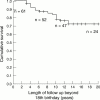The Fontan procedure in adults
- PMID: 11514490
- PMCID: PMC1729885
- DOI: 10.1136/heart.86.3.330
The Fontan procedure in adults
Abstract
Setting: Tertiary adult congenital cardiac referral centre.
Design: Retrospective cross sectional analysis.
Objectives: To report our 20 year experience with adult Fontan operations, and to compare late outcome in patients with single ventricle with definitive aortopulmonary or cavopulmonary shunt palliation.
Patients and main outcome measures: Patients older than 18 years undergoing Fontan operation between 1 January 1982 and 31 December 1998 were identified. Mortality and late outcome were derived from hospital records. These patients were compared with a cohort of 50 adults with single ventricle who had not undergone a Fontan operation.
Results: 61 adults, median age 36 years (range 18-47 years), with a median follow up of 10 years (range 0-21 years) were identified. Actuarial survival was 80% at one year, 76% at five years, 72% at 10 years, and 67% at 15 years. Compared with before the Fontan operation, more patients were in New York Heart Association (NYHA) functional class I or II at the latest follow up (80% v 58%, p < 0.001). Systolic ventricular function deteriorated during follow up such that 34% had moderate to severe ventricular dysfunction at the latest follow up compared with 5% before Fontan (p < 0.001). Arrhythmia increased with time (10% before Fontan v 57% after 10 years, p < 0.001). Fontan patients had improved NYHA functional class, ventricular function, atrioventricular regurgitation, and fewer arrhythmias than the non-Fontan group at the latest follow up.
Conclusion: The Fontan operation in adults has acceptable early and late mortality. Functional class, systolic ventricular function, atrioventricular regurgitation, and arrhythmia deteriorate late after surgery but to a lesser degree than in non-Fontan patients with a single ventricle.
Figures





References
Publication types
MeSH terms
LinkOut - more resources
Full Text Sources
Medical
